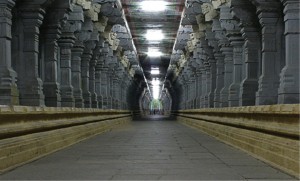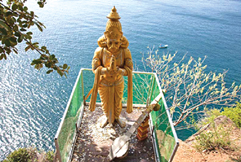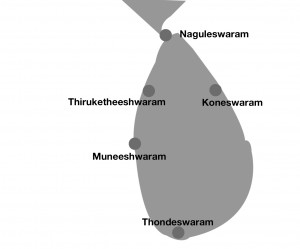Registered with the Registrar of Newspapers for India under R.N.I 53640/91
Vol. XXVI No. 01, April 16-30, 2016
Rameswaram’s links with Sri Lanka
Pamban Island, Rameswaram and Dhanushkodi (MM, November 2015) have been close to my heart ever since I used to travel between Egmore railway station and Colombo several times annually between 1939 and 1945, when I was 6 to 11 years old. We used to marvel at the scale model of the steamer S.S. Elgin or S.S. Hardinge, kept in a glass case at Egmore. We would embark on the Boat Mail in the evening and reach Pamban Bridge by the next afternoon. It was quite an experience going across the bridge, with heavy winds blowing through the train from the sea on either side of it! After stopping at Pamban, it used to go to Dhanushkodi station. Then it would reverse to Dhanushkodi Pier, so that the heavy railway engine did not have to go onto the pier.
Seeing the photo in MM, February 16, 2014, I recollected how we would step down from the coach onto the pier and straight onto the steamer, since there were two tracks to suit the side of the pier the ship was berthed at. It was indeed an engineering marvel – inaugurated on February 24, 1914.
In later years, soon after World War II, Tata Airlines with its Dakota once flew me from Colombo via Trichinopoly to Madras, due to bad weather near Jaffna. From my window seat, I could see Adam’s Bridge from the air. That impression is still in my mind’s eye. All this journeying had long kept Rameswaram in memory.
* * *
While I was working in plantations near Vandiperiar in the 1970s, I visited Rameswaram with my family and friends. We left one morning from Kerala and travelled to Rameswaram. There was no road link those days and we had to park our cars on the mainland at Mandapam, take a train to Pamban railway station and then hire two jutkas to go to Rameswaram temple. The waters of Palk Bay have no waves except gentle ripples. All of us could wade through the shallow waters for over 100 to 200 metres, take several dips, come to the shore, change our clothes and get to the temple, which adjoins the shore.
 The famed thousand pillared corridor of Rameswaram Temple.
The famed thousand pillared corridor of Rameswaram Temple.Rameswaram temple’s sanctum sanctorum was built by Parakrama Bahu I, the ruler of Sri Lanka from 1153-1188 AD. He obviously travelled with his soldiers, craftsmen, technicians, worshippers and pilgrims on the land route, Adam’s Bridge between Mannar and Rameswaram. Parakrama Bahu, the all powerful king of Sri Lanka, was also considered a sage. He named his royal palace ‘Palace of God Indira’. Further, being a Shiva Baktha, a 11th Century temple known as Vanam Madevi Iswaram, named after Rajaraja I, the Chola conqueror, who established his capital at Polonnaruwa, was preserved here during Parakrama Bahu’s reign. Other Hindu temples were also cared for. One of his wives had the name Subhadra.
The philosophy of the king was “let not even one drop of water reach the sea without serving man”, a view similar to that of Chola King Karikalan, who built the anicut (what is now called The Great Anicut) across the River Kaveri in the 2nd Century CE and which was remodelled by the British in 1804. It used to irrigate nearly 70,000 acres, but now irrigates over a million acres. This is considered one of the oldest water regulators still in use in the world.
Similarly, Jayaweera, King of Jaffna (1380-1410) and his dynasty till 1624, organised black granite stones to make pillars and other ornamentation on site near Trincomalee and then transported them by ship to Rameswaram temple. How many ships would have had to be commissioned and how many skilled artisans would have had to be employed and how many people would have been needed to create and load and unload all this work, including 1212 pillars, is mind boggling.
The Jaffna kingdoms (1215-1624) contributed to Rameswaram for 400 years and were known as Setukavalar, meaning custodians of the temple. Setu was used in their coins as well as their inscriptions. The ancestors of the King Aryachakravarthi dynasty that ruled Jaffna belonged to a Brahmin priest class of the Pasupathi sect of Rameswaram temple.
 Koneswaram Temple, Ravana
Koneswaram Temple, Ravanaworshipping Shiva, with the sea in the
background. Trincomalee, Sri Lanka.
In 1795, Rameswaram came under English East India Company governance.
* * *
Sri Lanka is home to five abodes of Lord Shiva which are known as Pancha Ishwaram. All of them are located along or near the coastline. They are Naguleswaram, Katheeswaram, Konneswaram, Tondeswaram and Muneswaram and are not considered among the 275 temples that are revered as the greatest Shiva shrines of India and Sri Lanka.
Naguleswaram temple is near Kankesanthurai in Jaffna, close to the Indian Ocean. Ketheeshwaran temple is in Mannar District, in northwest Sri Lanka. Its antiquity dates from 300 BCE to 1300 CE. It was maintained by Pallava and later Chola dynasties, but was largely destroyed by the Portuguese in 1575 and rebuilt at the original site in 1903. The site is considered an Buried City”. Nearby is Tirukut Ishwaram, one of the most famous of all Saivite shrines of the pre-Christian era. Excavations have uncovered ancient Saivite images and Roman coins which bear evidence of the age and repute of the port of Mantai, now called Mantota, near modern Mannar, once one of the great emporiums of the East. In fact, the wealth that flowed through the port is said to have financed the glorious architecture of ancient Anuradhapura, first capital of Sri Lanka.
Koneswaram temple, Trincomalee, on the east coast of Sri Lanka, was once a temple of 1000 pillars. The temple was developed during 205 BCE. This was regarded as the greatest building of its time. The original temple was destroyed by the Portuguese in 1622–1624. The temple was restored in 1963. The temple is on the same longitude as Mount Kailash in Tibet. Hence, it is also called Dakshina Kailash. It location is known as Tiru-kona-malai (hill of three sides), which has undergone metamorphosis into Trincomalee. The temple is located on a steep cliff of black granite rock, with the sea some 350 feet below.

Pancha Iswaram locations in Sri Lanka.
One pillar from the great pagoda still stands on top of Swami Rock, which is also called ‘Lover’s Leap’ or ‘Ravana’s Cleft’.
The significance of this temple is that it is dedicated to Ravanan. The temple has his 10-headed image and there is also a standing statue of Ravanan facing the land, worshipping Shiva. There is also here a huge statue of Shiva in a sitting posture, as Ravanan was a worshiper and a great devotee of Shiva.
The Tanavaram temple complex is in Matara, near Galle, and was designed in Kerala and built in Pallava style. The central shrine is dedicated to Vishnu. Other shrines include ones for Ganesha, Murugan, Kannagi and Shiva. This shrine is venerated as the southernmost of the five Ishwaram-s. The principal deity was known as Chandra Moul Eswaram, that is “Lord Shiva wearing the moon”, and was popularly called Tondeeswaram.
Munneswaram temple has been in existence from 1000 CE. This temple complex dedicated to Shiva is a collection of five temples, including a Buddhist temple. All these are located in Puttalam District, in Munneswaram village, on the west coast. It is said that Lord Rama worshiped Shiva here, after his victorious war against Ravanan, King of Sri Lanka. The place is also a centre for the Kali cult.
* * *
There has been recent revival of a plan to link Dhanushkodi and Sri Lanka by road at a cost $5.19 billion. If the road materialises, it will be a boon to pilgrims. There are many Hindu pilgrim centres in Sri Lanka that Indians from all parts of the country would like to visit.
K.V.S. Krishna

